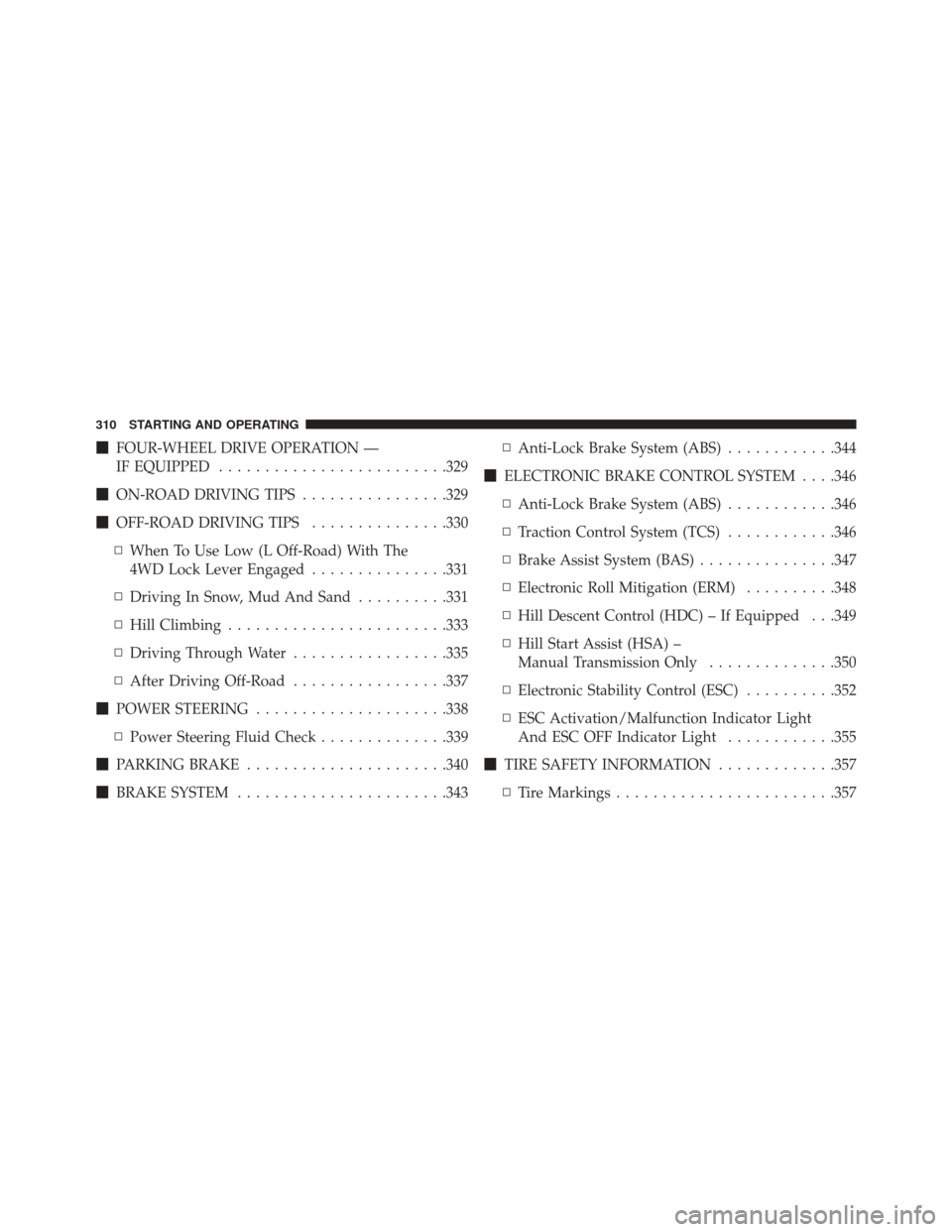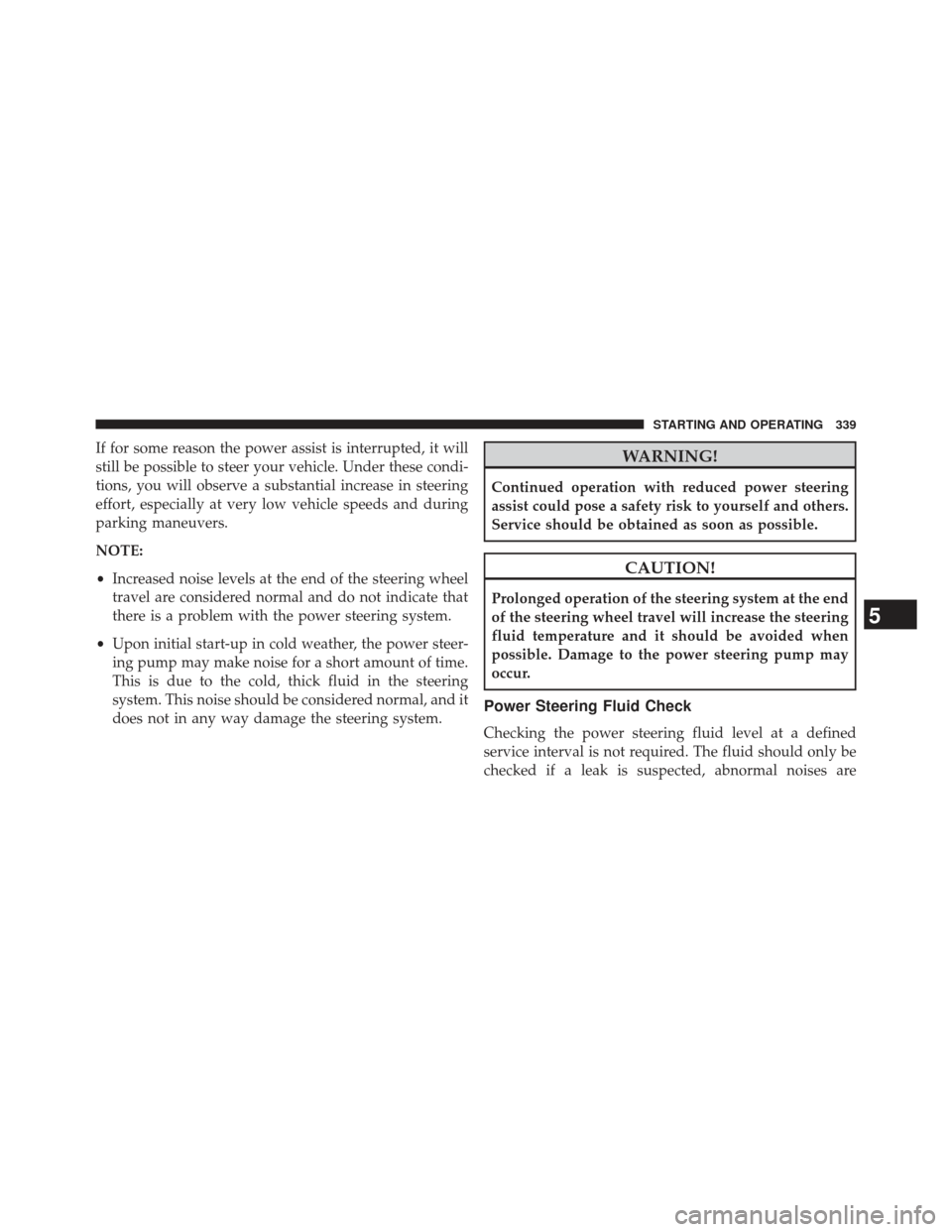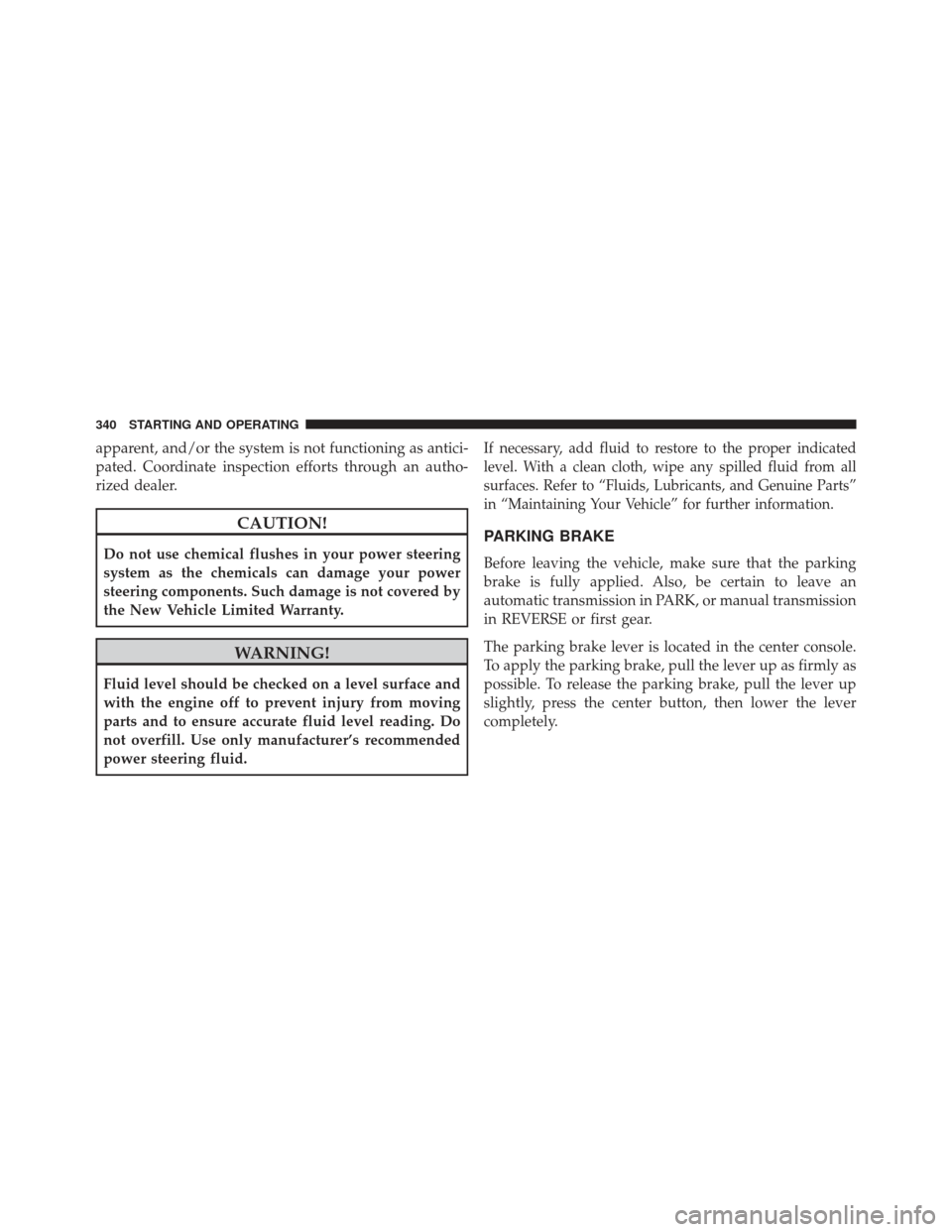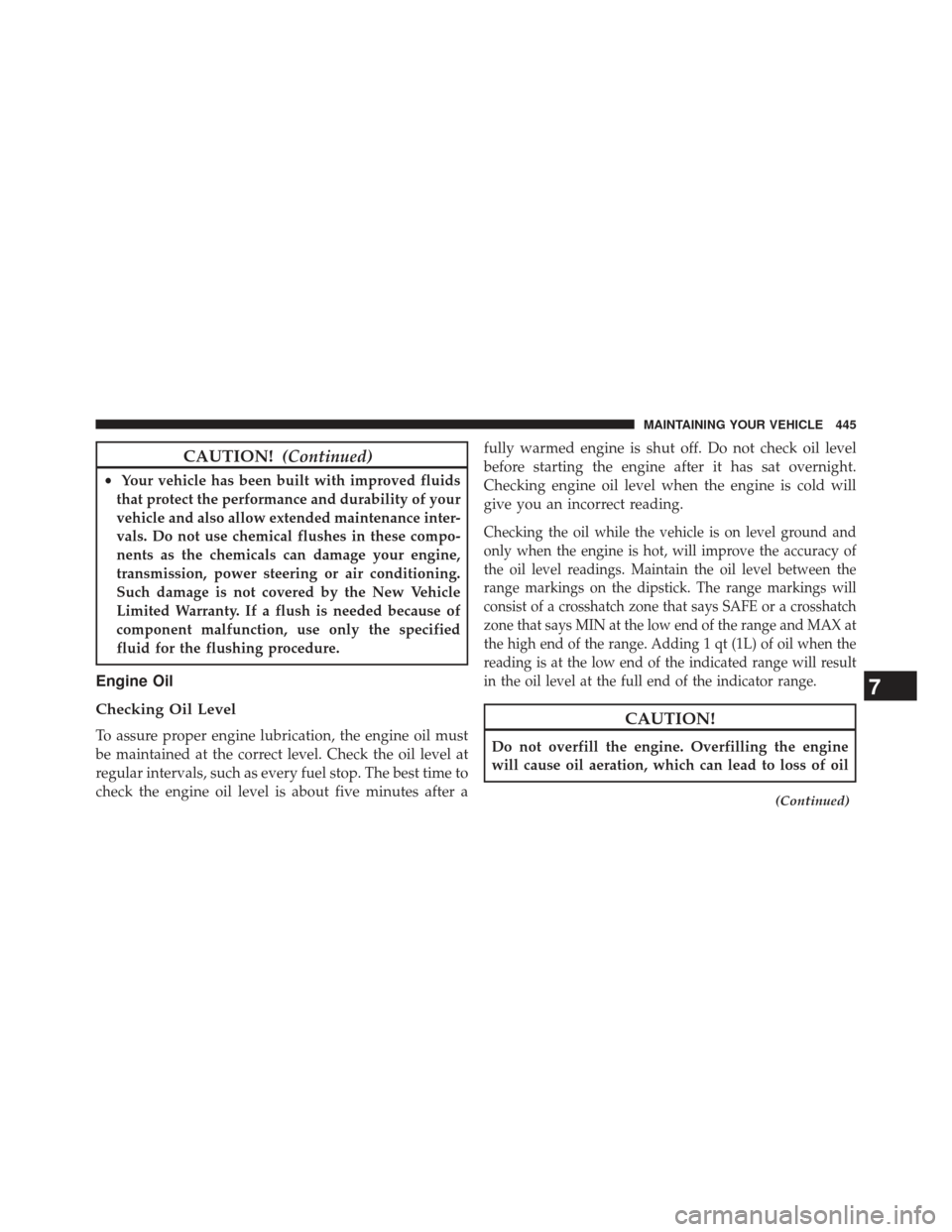Page 103 of 525
Door Latches
Check for positive closing, latching, and locking.
Fluid Leaks
Check area under vehicle after overnight parking for fuel,
engine coolant, oil, or other fluid leaks. Also, if gasoline
fumes are detected or if fuel, power steering fluid, or
brake fluid leaks are suspected, the cause should be
located and corrected immediately.
2
THINGS TO KNOW BEFORE STARTING YOUR VEHICLE 101
Page 312 of 525

�FOUR-WHEEL DRIVE OPERATION —
IF EQUIPPED ........................ .329
� ON-ROAD DRIVING TIPS ................329
� OFF-ROAD DRIVING TIPS ...............330
▫ When To Use Low (L Off-Road) With The
4WD Lock Lever Engaged ...............331
▫ Driving In Snow, Mud And Sand ..........331
▫ Hill Climbing ....................... .333
▫ Driving Through Water .................335
▫ After Driving Off-Road .................337
� POWER STEERING .....................338
▫ Power Steering Fluid Check ..............339
� PARKING BRAKE ..................... .340
� BRAKE SYSTEM ...................... .343▫
Anti-Lock Brake System (ABS) ............344
� ELECTRONIC BRAKE CONTROL SYSTEM . . . .346
▫ Anti-Lock Brake System (ABS) ............346
▫ Traction Control System (TCS) ............346
▫ Brake Assist System (BAS) ...............347
▫ Electronic Roll Mitigation (ERM) ..........348
▫ Hill Descent Control (HDC) – If Equipped . . .349
▫ Hill Start Assist (HSA) –
Manual Transmission Only ..............350
▫ Electronic Stability Control (ESC) ..........352
▫ ESC Activation/Malfunction Indicator Light
And ESC OFF Indicator Light ............355
� TIRE SAFETY INFORMATION .............357
▫ Tire Markings ....................... .357
310 STARTING AND OPERATING
Page 341 of 525

If for some reason the power assist is interrupted, it will
still be possible to steer your vehicle. Under these condi-
tions, you will observe a substantial increase in steering
effort, especially at very low vehicle speeds and during
parking maneuvers.
NOTE:
•Increased noise levels at the end of the steering wheel
travel are considered normal and do not indicate that
there is a problem with the power steering system.
• Upon initial start-up in cold weather, the power steer-
ing pump may make noise for a short amount of time.
This is due to the cold, thick fluid in the steering
system. This noise should be considered normal, and it
does not in any way damage the steering system.WARNING!
Continued operation with reduced power steering
assist could pose a safety risk to yourself and others.
Service should be obtained as soon as possible.
CAUTION!
Prolonged operation of the steering system at the end
of the steering wheel travel will increase the steering
fluid temperature and it should be avoided when
possible. Damage to the power steering pump may
occur.
Power Steering Fluid Check
Checking the power steering fluid level at a defined
service interval is not required. The fluid should only be
checked if a leak is suspected, abnormal noises are
5
STARTING AND OPERATING 339
Page 342 of 525

apparent, and/or the system is not functioning as antici-
pated. Coordinate inspection efforts through an autho-
rized dealer.
CAUTION!
Do not use chemical flushes in your power steering
system as the chemicals can damage your power
steering components. Such damage is not covered by
the New Vehicle Limited Warranty.
WARNING!
Fluid level should be checked on a level surface and
with the engine off to prevent injury from moving
parts and to ensure accurate fluid level reading. Do
not overfill. Use only manufacturer’s recommended
power steering fluid.
If necessary, add fluid to restore to the proper indicated
level. With a clean cloth, wipe any spilled fluid from all
surfaces. Refer to “Fluids, Lubricants, and Genuine Parts”
in “Maintaining Your Vehicle” for further information.
PARKING BRAKE
Before leaving the vehicle, make sure that the parking
brake is fully applied. Also, be certain to leave an
automatic transmission in PARK, or manual transmission
in REVERSE or first gear.
The parking brake lever is located in the center console.
To apply the parking brake, pull the lever up as firmly as
possible. To release the parking brake, pull the lever up
slightly, press the center button, then lower the lever
completely.
340 STARTING AND OPERATING
Page 441 of 525
ENGINE COMPARTMENT — 2.0L
1 — Washer Fluid Reservoir6 — Air Cleaner Filter
2 — Power Steering Fluid Reservoir 7 — Coolant Pressure Cap
3 — Engine Oil Fill 8 — Engine Oil Dipstick
4 — Brake Fluid Reservoir 9 — Engine Coolant Reservoir
5 — Integrated Power Module (Fuses)
7
MAINTAINING YOUR VEHICLE 439
Page 442 of 525
ENGINE COMPARTMENT — 2.4L
1 — Washer Fluid Reservoir6 — Air Cleaner Filter
2 — Power Steering Fluid Reservoir 7 — Coolant Pressure Cap
3 — Engine Oil Fill 8 — Engine Oil Dipstick
4 — Brake Fluid Reservoir 9 — Engine Coolant Reservoir
5 — Integrated Power Module (Fuses) 440 MAINTAINING YOUR VEHICLE
Page 447 of 525

CAUTION!(Continued)
•Your vehicle has been built with improved fluids
that protect the performance and durability of your
vehicle and also allow extended maintenance inter-
vals. Do not use chemical flushes in these compo-
nents as the chemicals can damage your engine,
transmission, power steering or air conditioning.
Such damage is not covered by the New Vehicle
Limited Warranty. If a flush is needed because of
component malfunction, use only the specified
fluid for the flushing procedure.
Engine Oil
Checking Oil Level
To assure proper engine lubrication, the engine oil must
be maintained at the correct level. Check the oil level at
regular intervals, such as every fuel stop. The best time to
check the engine oil level is about five minutes after a fully warmed engine is shut off. Do not check oil level
before starting the engine after it has sat overnight.
Checking engine oil level when the engine is cold will
give you an incorrect reading.
Checking the oil while the vehicle is on level ground and
only when the engine is hot, will improve the accuracy of
the oil level readings. Maintain the oil level between the
range markings on the dipstick. The range markings will
consist of a crosshatch zone that says SAFE or a crosshatch
zone that says MIN at the low end of the range and MAX at
the high end of the range. Adding 1 qt (1L) of oil when the
reading is at the low end of the indicated range will result
in the oil level at the full end of the indicator range.
CAUTION!
Do not overfill the engine. Overfilling the engine
will cause oil aeration, which can lead to loss of oil
(Continued)
7
MAINTAINING YOUR VEHICLE 445
Page 485 of 525
Chassis
ComponentFluid, Lubricant, or Genuine Part
Automatic Transmission (CVT) – If Equipped We recommend you use MOPAR �CVTF+4� Continuously
Variable Transmission Fluid.
Manual Transmission – If Equipped We recommend you use MOPAR�ATF+4� Automatic Transmis-
sion Fluid.
Rear Drive Assembly (RDA) We recommend you use MOPAR�Gear & Axle Lubricant
SAE 80W-90 API GL 5.
Power Transfer Unit (PTU) We recommend you use MOPAR�Gear & Axle Lubricant
SAE 80W-90 API GL 5.
Brake Master Cylinder We recommend you use MOPAR�DOT 3, SAE J1703 should
be used. If DOT 3, SAE J1703 brake fluid is not available, then
DOT 4 is acceptable.
Power Steering Reservoir We recommend you useMOPAR�Power Steering Fluid +4,
MOPAR� ATF+4�Automatic Transmission Fluid.
7
MAINTAINING YOUR VEHICLE 483